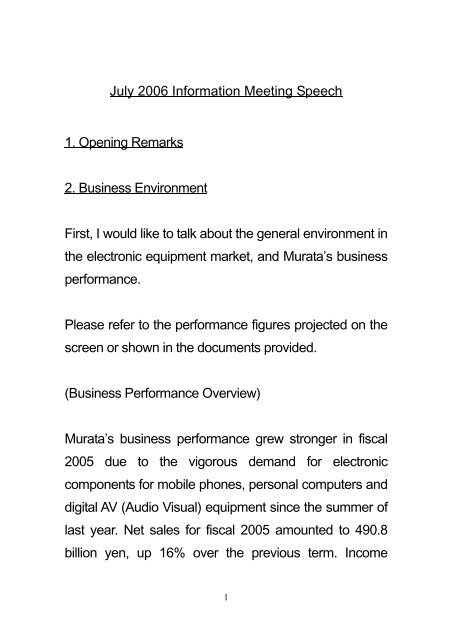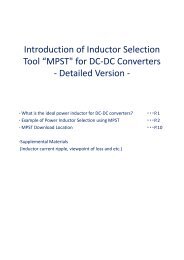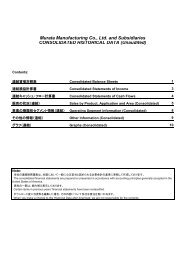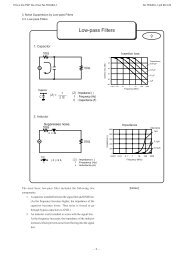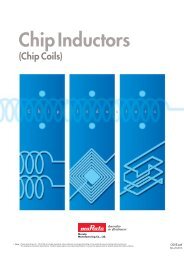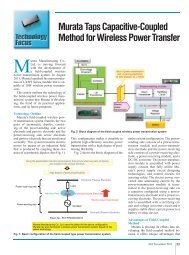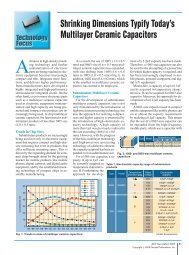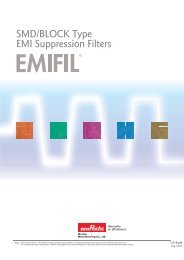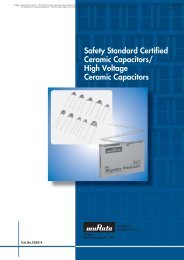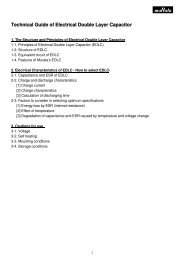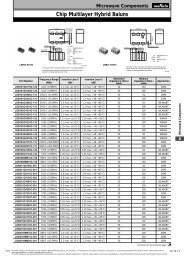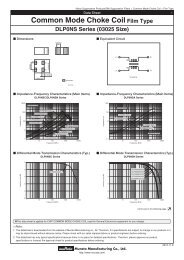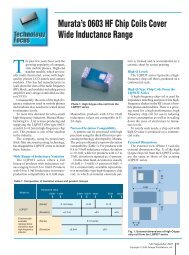July 2006 Information Meeting Speech 1. Opening ... - Murata
July 2006 Information Meeting Speech 1. Opening ... - Murata
July 2006 Information Meeting Speech 1. Opening ... - Murata
- No tags were found...
You also want an ePaper? Increase the reach of your titles
YUMPU automatically turns print PDFs into web optimized ePapers that Google loves.
<strong>July</strong> <strong>2006</strong> <strong>Information</strong> <strong>Meeting</strong> <strong>Speech</strong><strong>1.</strong> <strong>Opening</strong> Remarks2. Business EnvironmentFirst, I would like to talk about the general environment inthe electronic equipment market, and <strong>Murata</strong>’s businessperformance.Please refer to the performance figures projected on thescreen or shown in the documents provided.(Business Performance Overview)<strong>Murata</strong>’s business performance grew stronger in fiscal2005 due to the vigorous demand for electroniccomponents for mobile phones, personal computers anddigital AV (Audio Visual) equipment since the summer oflast year. Net sales for fiscal 2005 amounted to 490.8billion yen, up 16% over the previous term. Income1
efore income taxes was 9<strong>1.</strong>7 billion yen, up 26%, andnet income came to 58.4 billion yen, also up 26%.<strong>Murata</strong> is expecting continued growth in fiscal <strong>2006</strong>, withnet sales forecast at 540 billion yen, up 10% over theprevious term. Income before income taxes is estimatedat 105 billion yen, up 15%, with net income expected toreach 66 billion yen, up 13%.(Demand growth driven by rising production of electronicequipment)Demand for electronic equipment continues to expand inmarkets around the world. In fiscal <strong>2006</strong>, worldwidedemand of electronic components for mobile phones isexpected to reach 950 million sets, up 15% over theprevious term, while demand of components used in PCsis estimated at 240 million sets, up 9%.In the AV equipment market, sales of flat-screentelevisions are expected to double over the year before,2
with sales of LCD and plasma TVs set to reach 42 millionunits and 11 million units, respectively.Additionally, production of HDDs (Hard Disk Drives) isexpected to expand, due to their growing use in portablemusic players such as the iPod, new models of gamingdevices to be released in <strong>2006</strong>, DVD recorders, andvarious mobile devices outside PC applications.(Growing component demand and changing demandpatterns due to functional sophistication and digitalizationof electronic equipment)The continued digitalization and incorporation of moreadvanced functions into electronic equipment aregenerating new demand for <strong>Murata</strong> electroniccomponents. For example, the use of <strong>Murata</strong>components in the new 3G mobile phones, which is nowset for full-scale diffusion, is <strong>1.</strong>5 to 2 times higher per unitthan in earlier phones. Starting from features such ascolor displays and built-in cameras, the inclusion of3
functions such as Bluetooth R(*) connectivity and terrestrialdigital broadcast reception in more and more mobilephones is also driving up demand for <strong>Murata</strong>components.Another noteworthy shift is the growing use of dual-coreMPUs in PCs, which means that sales of ceramiccapacitors (MLCCs) per MPU will approximately double,compared with conventional single-core MPUs.The explosion of the flat-screen TV market is spurringvigorous growth in demand for <strong>Murata</strong> components.While a conventional 15-inch CRT TV typically containsonly 200 ceramic capacitors, a single 32-inch or largerLCD or other flat-screen TV contains 700 to 1,400capacitors.(High-growth areas of the electronic equipment market)Rapid growth is expected in numerous fields of theelectronic equipment market.4
The wireless telecommunication market is expandingsignificantly in line with the development of a “ubiquitousnetwork society” that extends beyond mobile equipment,to automobiles and home electrical appliances. While themarket for <strong>Murata</strong> products in the wirelesstelecommunication equipment market is already verylarge—for mobile phones, wireless LANs, and BluetoothRfunctions—this market is expected to grow further withthe introduction of new wireless telecommunicationtechnologies such as UWB, Zigbee and WiMax.In Japan it is now possible to receive the recentlyintroduced digital terrestrial broadcasts with mobiledevices. The use of mobile phones to receive digitalbroadcasts is expected to grow in overseas markets too,through use of the DVB-H (Digital Video Broadcasting forHandheld) standard. We expect to see a worldwideadoption of this technology.Electronification will also continue to advance in the5
automobile market, as typified by the diffusion of hybridcars. More and more electronic components are beingused in automobiles, for functions such as automotiveLAN, RKE (Remote Keyless Entry), and TPMS (TirePressure Monitoring System). Other factors expected todrive growth in the automobile electronics market are thewidespread use of car navigation systems and ETC(Electronic Toll Collection), and the launch of DSRC(Dedicated Short Range Communication) services.(Medium-term demand growth, capital expenditureplanning and enhanced production capacity)We forecast that demand for <strong>Murata</strong> components willgrow by over 10% per year for the next two to three years,due to rising production in the electronic equipmentmarket, and our active cultivation of opportunities in newand emerging fields of the electronic equipment market.By maintaining a high level of spending on R&D—sevento eight percent of net sales—<strong>Murata</strong> has managed to6
generate as much as 37% of its net sales from newproducts.We also have a policy of making active use of intellectualproperties. The number of our patent applications ranksamong the top class within the industry, and in 2005, thenumber of patent registration in the U.S. was the highestamong Japanese component manufacturers. We placeemphasis not only on the number of patents but also onthe quality of patents.In the face of the structural change in demands in theelectronic components market, due to digitalization andincreasing functional sophistication, our new productswith advanced functions will enable us to achieve ahigher rate of growth than the market as a whole.In view of this, <strong>Murata</strong> is planning to meet this risingdemand through actively increasing its productioncapacity.7
We are planning to increase capital expenditures in fiscal<strong>2006</strong> to a massive 80 billion yen, up 57% over theprevious term.Of the 80 billion yen budgeted for capital expenditures, 45billion yen is targeted to production facilities, to enhanceproduction capacity for products for which demand isexpected to grow—such as capacitors, noisesuppression components, microwave devices, andBluetooth R modules. A sum of 20 billion yen is set asidefor investment in new buildings, for products such asMLCCs, microwave devices, power supplies, and rawmaterials, in preparation for business expansion in two tothree years time.8
3. Product Trends and Marketing StrategiesNext, I would like to explain some market trends anddiscuss our strategies for our major products.1 Capacitors, noise suppression components, andsensor-related products(Capacitors, piezoelectric products, and noisesuppression components, made with ceramic materials)<strong>Murata</strong>’s capacitors, piezoelectric products and noisesuppression components hold a high market share, dueto the efforts we have made to utilize the characteristicsof ceramic materials in developing new products withadvanced functions. Manufacturing our own ceramicmaterials has contributed to these products as beingsome of the most profitable within our product portfolio.(1) Capacitors(Large-capacitance ceramic capacitors whose sales aregrowing rapidly, through miniaturization and larger9
capacitance)Firstly, sales of large-capacitance MLCCs are growingrapidly with the shift of electronic equipment to higherfrequency and more advanced functions. Year-on-yearsales of large-capacitance MLCCs of capacitance over 1µF in fiscal 2005 increased more than 20% for thesecond straight year. Sales of such capacitors in fiscal<strong>2006</strong> are expected to grow by approximately 15%.<strong>Murata</strong> was the first company to establish a massproductionsystem for large-capacitance MLCCs with 1µm thin-layer dielectrics, which represents the state-ofthe-artin the industry. With this, sales of compact largecapacitanceMLCCs such as the 1608-size 10-µF and2012-size 22-µF products grew significantly. In addition,<strong>Murata</strong> has commercialized 3216-size 100-µF capacitorsfor power circuits and other applications, and is currentlyworking towards bringing 2012-size 100-µF product intothe market.10
Through these approaches, <strong>Murata</strong> has enhanced itsrange of compact large-capacitance MLCCs. We are alsopromoting the replacement of electrolytic capacitors,such as tantalum based products, with ceramiccapacitors. Already in use at capacities of 4.7 µF or less,ceramic capacitors are rapidly replacing tantalums byprogressing to 10 µF and beyond.We foresee that demand for large-capacitance MLCCswill grow rapidly in the fields of mobile phones, PCs,digital AV equipment, and gaming devices, in line with thetrend towards smaller size and more advanced functions.(Expansion of application-specific capacitors withadvanced MPU functionality)<strong>Murata</strong> enjoys a large share of the market for low-ESLtype capacitors, which are application-specific capacitorsused as components for MPUs in PCs.The proportion of MPUs with multiple cores—in which11
more than two processor cores are integrated into asingle package—is growing sharply. In view of this,demand for low-ESL type and large-capacitancecapacitors is expected to rise. The shift to more advancedfunctions and multi-core MPUs is progressing not only inthe PC and server markets as before, but also in thegaming device and automobile electronics markets. Weexpect that net sales of low-ESL type capacitors willcontinue to grow greatly.(Small capacitors that contribute to functionalsophistication of electronics equipment)The market for 0603-size capacitors, of which <strong>Murata</strong>holds a large share, continues to expand in line with theshift to smaller and more advanced electronic equipment.Net sales have grown by some 50% per year over thepast several years. These 0603-size capacitors are usednot only in power amplifier modules for mobile phonesbut also for the main boards of mobile phones, digital stillcameras, and portable gaming devices.12
In addition, <strong>Murata</strong> became the first company in theindustry to commercialize 0402-size capacitors. Thesecapacitors are starting to be used in the power amplifiermodules for mobile phones.(Improved profit structure of capacitors)High added-value products such as large-capacitanceMLCCs, application-specific capacitors and 0603-sizecapacitors, account over half of <strong>Murata</strong>’s total net sales ofcapacitors.Furthermore, <strong>Murata</strong> has been working on thedevelopment and commercialization of thin-layerdielectrics of less than <strong>1.</strong>0 µm, in order to create new highadded-value products. <strong>Murata</strong> is differentiating itself fromother manufacturers in the industry and improving itsprofitability by utilizing its technological expertise tocontinue creating new products offering advancedfunctions.13
(2) Noise suppression components (EMIFIL, chip coils)(High profitability of noise suppression components andsensor-related products)<strong>Murata</strong>’s noise suppression components and sensorrelatedproducts are produced using the company’s ownceramic materials and production technologies. Like ourcapacitors, these are highly profitable products.(Demand growth driven by digitalization and increasingfunctional sophistication in equipment)Demand for noise suppression products is growing, asthe trend to digitalization and the increasing functionalsophistication of equipment has given rise to higherlevels of electronic noise. Unit sales of our noisesuppression components have grown steadily over thepast few years, thereby offsetting the effect of pricedeclines.14
Noise suppression components are used in various kindsof electronic equipment. Our sales of chip ferrite beadEMI filters (BLM) and chip inductor coils (LCHIP)continue to grow, as mobile phones are equipped withmore and more functions and higher frequencycomponents. In addition, demand for chip three-terminalcapacitors (NFM), used for noise suppression of powersupply lines in digital AV equipment, and chip commonmodechoke coils (DCC), which effectively remove noisegenerated by high-speed interfaces such as USB2.0, isgrowing for PCs, communications devices and digital AVequipment.(3) Sensor-related products(GYROSTAR R for image stabilization and shock sensorsfor HDD vibration detection)Next up, let’s look at sensor-related products. The use ofGYROSTAR R components for image stabilization indigital still cameras is growing. Up to now, suchcomponents were used mainly in digital video cameras.15
However, while worldwide production of digital videocameras amounts to only 15 million units per year,production of digital still cameras is projected to be some100 million units per year. In view of this fact, demand forGYROSTAR R is increasing sharply.Sales of shock sensors are rising too, mainly for vibrationdetection in HDDs. Most of the 2.5-inch and smallerHDDs that are used in portable devices have shocksensors built in, but shock sensors are now increasinglyfinding their way into 3.5-inch HDDs too, because of theirhigher capacity and higher density of data storage.<strong>Murata</strong> holds a very high share of the market for thesesensor-related products. Net sales of these products forfiscal 2005 were up more than 30% over the previousyear.(Expanding application of sensor-related products)In addition to those just mentioned, the application of16
sensor-related products is expected to expand in variousother fields too. For example, <strong>Murata</strong> has addressed theautomobile electronics market by commercializing thegyroscopes using the MEMS (Micro Electro MechanicalSystems) technology for car navigation systems. We alsoproduce various sensors including shock sensors for airbags. Since our sensor-related products are alsoexpected to find use in gaming devices and otherequipment, we forecast substantial sales growth for theseproducts.2 Microwave Devices(SAW filters)<strong>Murata</strong> has been focusing its attention on the mobilephone market and has been producing microwavedevices since the early stage of the market.These products include SAW filters, which are keycomponents in the RF circuits of mobile phones. Demandfor these has soared with the rise in production of mobilephones. The advent of multi-band phones has also led to17
the need for higher numbers of SAW filters per phone.While conventional mobile phones required two to threeSAW filters, multi-band 3G phones use up to six to sevenfilters per unit.To meet the demand for smaller and more complex SAWfilters, <strong>Murata</strong> is applying chip-size packaging technologyto dual-type SAW filters and SAW duplexers.At the same time, to keep ahead of our competitors, wehave been improving our delivery times and servicestandards. <strong>Murata</strong>’s market share for the SAW filtersused for high-frequency bands is growing rapidly, almostovertaking the market leader.(Production of other high-frequency products)Aside from SAW filters, <strong>Murata</strong>’s other microwavedevices include switch connectors for mobile phones;antennas for multi-band devices; and small isolators usedin the transmitters of 3G mobile phones. Demand for all18
these products is also rising.3 Module products(Expansion of module business through design-in forprime customers)Next up, we turn our attention to the business of wirelessmodule products. Sales are expected to grow, as ourcustomers increasingly seek to purchase components inthe form of modules. In addition, our use of chipcomponents in modules is causing a synergy effect forthe <strong>Murata</strong> group as a whole. Since module products arehighly customized and application-specific, electroniccomponent manufacturers are required to advancebusiness through collaboration with prime customersfrom the development and design stage. <strong>Murata</strong> ispursuing growth in its module business by constructingclose ties with the leading mobile phone manufacturersand furthering its design-in activities.(1) Bluetooth R modules19
(Growth in sales of Bluetooth R modules)The proportion of mobile phones equipped with Bluetooth–for which <strong>Murata</strong> supplies module products– is growing,mainly in the U.S. and Europe. The ratio of Bluetooth R -equipped mobile phones will rise from about 25% in fiscal2005 to 35% in fiscal <strong>2006</strong>, and is expected to reach 50%within the next several years.<strong>Murata</strong> holds a large share in the market for Bluetooth Rmodules used in mobile phones. A strong demand forminiaturization, and the rise in Bluetooth R -equippedphones are significant contributors toward increasingdemand for <strong>Murata</strong> technology. Net sales of Bluetooth Rmodules tripled in fiscal 2005 to 45 billion yen. In fiscal<strong>2006</strong> this figure is expected to rise to 64 billion yen.(Development of LTCC technology)The high cost of the components mounted on substrateserodes the profitability of Bluetooth modules and other20
types of wireless modules. To boost the added value ofmodules, <strong>Murata</strong> is working to expand sales of modulesmade using low temperature co-fired ceramics (LTCC)technology, which enables multiple functions to beincorporated on a single ceramic substrate. The rawmaterials for the substrates are manufactured internally.Our use of LTCC technology over the years hasgenerated very substantial sales growth, initially fromchip-type LC filters and then later from RF modules andBluetooth R modules. This has enabled us to establish asolid standing as a manufacturer of electroniccomponents in the market for short-distance wirelesscommunications.(2) Effective utilization of external resources - Buyout ofSyChip Inc. -(Buyout of SyChip Inc.)In April <strong>2006</strong>, <strong>Murata</strong> concluded the buyout of the U.S.venture company SyChip Inc., for a price of21
Zigbee.23
4. Financial Strategy (dividend, share buy-back)Finally, I would like to explain <strong>Murata</strong>’s financial strategy.(Dividend strategy, share buy-back and return toshareholders)Our basic policy on returns to shareholders is to steadilyincrease the share dividend. In fiscal 2005 <strong>Murata</strong>increased the annual dividend per share to 70 yen, up 20yen over the previous term. In fiscal <strong>2006</strong>, we plan toincrease the annual dividend per share by 10 yen, to 80yen.In addition, we have been buying back our shares onthe stock market. In fiscal 2005, we bought back atotal of 2.81 million shares for a sum of 15.6 billion yen.In the four years since <strong>July</strong> 2002, we haverepurchased a total of 22.33 million shares for 122.9billion yen. Most of the shares repurchased havealready been retired.24
The rate of return to shareholders, which is the sum ofthe dividend and the value of repurchased stock,divided by the net income for the year, was 90% forfiscal 2003, 82% for fiscal 2004, and 53% for fiscal2005. This shows that <strong>Murata</strong> is actively returning thecompany’s earnings to its shareholders.(Cash utilization)On the other hand, our surplus funds are at a highlevel of approximately 440 billion yen. Given the rapidchanges in supply and demand and technologicalinnovation in the electronic components industry,<strong>Murata</strong> intends to respond to these changes flexiblyby utilizing its own capital. The 80 billion yen plannedfor this year’s capital expenditure, and theapproximate amount of 137 million U.S. dollars for thebuyout of SyChip Inc. are both financed internally.It is our policy to avoid accumulating surplus funds over25
the current level. That is, aside from necessaryinvestment capital, the cash earned from the businesswill be returned to shareholders, through dividend payoutsand share buy-backs.5. Closing Remarks(*) The Bluetooth Trademark is owned by BluetoothSIG, Inc., USA.26


